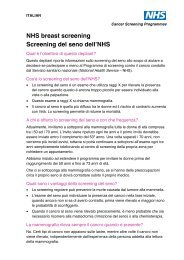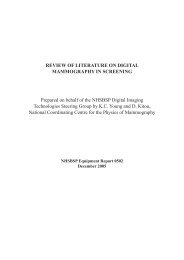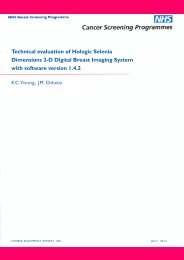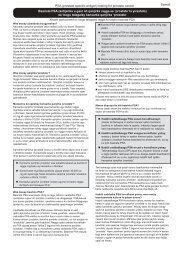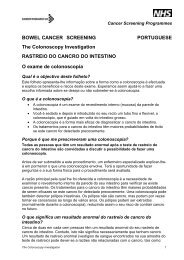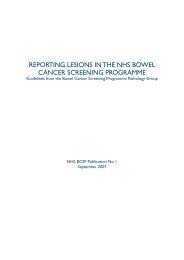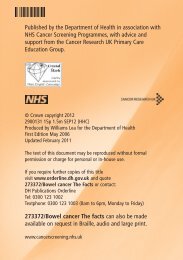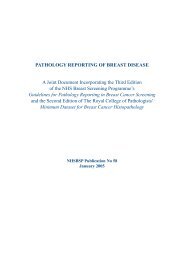Evaluation and clinical assessment of the hologic selenia
Evaluation and clinical assessment of the hologic selenia
Evaluation and clinical assessment of the hologic selenia
Create successful ePaper yourself
Turn your PDF publications into a flip-book with our unique Google optimized e-Paper software.
evaluation <strong>and</strong> CliniCal <strong>assessment</strong><br />
<strong>of</strong> <strong>the</strong> hologiC <strong>selenia</strong> dimensions<br />
full field direCt digital<br />
mammography unit<br />
NHSBSP Equipment Report 1003<br />
October 2010
Authors<br />
South East London Breast Screening Service<br />
King’s College Hospital<br />
Breast Radiology Department<br />
Cheyne Wing<br />
King’s College Hospital, Denmark Hill<br />
London<br />
SE5 9RS<br />
Tel: 020 3299 1964<br />
Fax: 020 3299 1966<br />
Published by<br />
NHS Cancer Screening Programmes<br />
Fulwood House<br />
Old Fulwood Road<br />
Sheffield<br />
S10 3TH<br />
Tel: 0114 271 1060<br />
Fax: 0114 271 1089<br />
Email: info@cancerscreening.nhs.uk<br />
Website: www.cancerscreening.nhs.uk<br />
© NHS Cancer Screening Programmes 2010<br />
The contents <strong>of</strong> this document may be copied for use by staff working in <strong>the</strong> public sector but may not be copied for any<br />
o<strong>the</strong>r purpose without prior permission from NHS Cancer Screening Programmes. The report is available in PDF format on<br />
<strong>the</strong> NHS Cancer Screening Programmes website.<br />
Typeset by Prepress Projects Ltd, Perth (www.prepress-projects.co.uk)<br />
Printed by Duffield Printers
CONTENTS<br />
Hologic Selenia Dimensions Full Field Direct Digital Mammography Unit | iii<br />
AckNOwlEdgEmENtS v<br />
1. ExEcutivE SummARy 1<br />
2. iNtROductiON ANd BAckgROuNd 2<br />
3. OBjEctivES Of tHE EvAluAtiON 3<br />
4. SyStEm dEScRiPtiON 4<br />
4.1 Hologic Selenia dimensions 4<br />
4.2 Hologic Securview dx reporting workstation 6<br />
4.3 workflow configuration 6<br />
5. AccEPtANcE tEStiNg, cOmmiSSiONiNg ANd PERfORmANcE tEStiNg 7<br />
6. ROutiNE QuAlity cONtROl 8<br />
7. imAgE QuAlity ASSESSmENt 11<br />
8. dAtA ON ScREENiNg cONductEd 13<br />
8.1 <strong>clinical</strong> dose audit 13<br />
8.2 clinic organisation <strong>and</strong> throughput 13<br />
9. dAtA ON ASSESSmENtS cONductEd 14<br />
10. EQuiPmENt REliABility 15<br />
11. mAmmOgRAPHERS’ cOmmENtS ANd OBSERvAtiONS 16<br />
11.1 Operator’s manual 16<br />
11.2 training 16<br />
11.3 Ease <strong>of</strong> use 16<br />
11.4 Exposure times 16<br />
11.5 Setting radiographic views 17<br />
11.6 Setting <strong>the</strong> position <strong>of</strong> <strong>the</strong> breast support table 17<br />
11.7 Range <strong>of</strong> movements 17<br />
11.8 Effectiveness <strong>of</strong> brakes <strong>and</strong> locks 17<br />
11.9 compression 17<br />
11.10 comfort level for <strong>the</strong> women being screened 18<br />
11.11 Range <strong>of</strong> controls <strong>and</strong> indicators 18<br />
11.12 choice <strong>of</strong> collimators supplied for spot compression 18<br />
11.13 time elapsing before <strong>the</strong> image arrives at <strong>the</strong> acquisition workstation 18<br />
11.14 image h<strong>and</strong>ling <strong>and</strong> processing facilities at <strong>the</strong> acquisition workstation 18<br />
11.15 Overall image quality at <strong>the</strong> acquisition workstation 19<br />
11.16 Ease <strong>of</strong> image transfer to <strong>the</strong> reporting workstation <strong>and</strong> to <strong>the</strong> hard copy printer 19<br />
NHSBSP October 2010
iv | Hologic Selenia Dimensions Full Field Direct Digital Mammography Unit<br />
11.17 level <strong>of</strong> confidence in <strong>the</strong> dimensions unit 19<br />
11.18 Hazards 19<br />
11.19 Equipment cleaning 19<br />
11.20 Patient <strong>and</strong> exposure data <strong>and</strong> post exposure print out facility 19<br />
11.21 did <strong>the</strong> performance <strong>of</strong> <strong>the</strong> digital x-ray system limit patient throughput? 20<br />
11.22 Additional comments on performance 20<br />
11.23 magnification 20<br />
11.24 Stereo 20<br />
12. RAdiOlOgiStS’/film REAdERS’ cOmmENtS ANd OBSERvAtiONS 21<br />
13. iNfORmAtiON SyStEmS 24<br />
14. cONfidENtiAlity 26<br />
15. SEcuRity iSSuES 27<br />
16. cONcluSiONS ANd REcOmmENdAtiONS 28<br />
17. REfERENcES 29<br />
APPENdix: cliNicAl dOSE SuRvEy 30<br />
NHSBSP October 2010
Hologic Selenia Dimensions Full Field Direct Digital Mammography Unit | v<br />
ACKNOWLEDgEMENTS<br />
<strong>the</strong> valuable contributions to <strong>the</strong> project <strong>of</strong> <strong>the</strong> following colleagues are gratefully acknowledged<br />
• james clinch <strong>and</strong> colleagues (king’s Radiation Protection Services, department <strong>of</strong> medical<br />
Engineering <strong>and</strong> Physics, king’s college Hospital NHS foundation trust)<br />
• david lee, Bob martins <strong>and</strong> colleagues (Hologic, inc)<br />
• mammographers, breast radiologists, breast radiology/screening administration staff, <strong>and</strong> it<br />
staff <strong>of</strong> <strong>the</strong> South East london Breast Screening Programme (king’s college Hospital NHS<br />
foundation trust)<br />
• Sarah Sellars (Assistant director, Breast Screening Programme, NHS cancer Screening<br />
Programmes)<br />
• Pr<strong>of</strong>essor ken young <strong>and</strong> dr jenny Oduko (National coordinating centre for Physics in<br />
mammography, department <strong>of</strong> medical Physics, Royal Surrey county Hospital).<br />
NHSBSP October 2010
vi | Hologic Selenia Dimensions Full Field Direct Digital Mammography Unit<br />
NHSBSP October 2010
Hologic Selenia Dimensions Full Field Direct Digital Mammography Unit | 1<br />
1. ExECUTivE SUMMARy<br />
<strong>the</strong> Hologic Selenia dimensions full field digital mammography unit was evaluated between late<br />
2009 <strong>and</strong> early 2010 to establish its suitability for use in <strong>the</strong> NHS Breast Screening Programme<br />
(NHSBSP). <strong>the</strong> evaluation included <strong>the</strong> Securview dx reporting workstation.<br />
<strong>the</strong> majority (90%) <strong>of</strong> observations in a subjective <strong>assessment</strong> <strong>of</strong> <strong>clinical</strong> image quality rated <strong>the</strong><br />
dimensions images as ‘<strong>the</strong> same as’ or ‘better than’ those acquired using <strong>the</strong> st<strong>and</strong>ard local film–<br />
screen system.<br />
most (83%) <strong>of</strong> <strong>the</strong> users <strong>of</strong> <strong>the</strong> mammography unit <strong>and</strong> acquisition workstation found its ease <strong>of</strong><br />
use ei<strong>the</strong>r ‘good’ or ‘excellent’. Although two-thirds <strong>of</strong> users believed that <strong>the</strong> design <strong>of</strong> <strong>the</strong> unit<br />
did not compromise throughput, a number disliked <strong>the</strong> fact that <strong>the</strong>y had to wait for an image to<br />
be displayed <strong>and</strong> select ‘accept’ on <strong>the</strong> control screen before positioning for <strong>the</strong> next acquisition.<br />
<strong>clinical</strong> radiation doses were reduced by approximately 29% on average when compared with<br />
<strong>the</strong> local film–screen system. Routine (radiographer) quality control measurements showed a high<br />
degree <strong>of</strong> system stability with results comfortably within NHSBSP thresholds.<br />
downtime during <strong>the</strong> screening evaluation period was 8.8% <strong>and</strong> some concern was expressed<br />
about <strong>the</strong> unit’s reliability. this could be explained partly by <strong>the</strong> fact that it was <strong>the</strong> first <strong>of</strong> its type<br />
to be installed in <strong>the</strong> uk <strong>and</strong> engineering support was initially supplied from Belgium.<br />
<strong>the</strong> Securview dx reporting station was well received by film readers, with all scoring its workflow<br />
as ei<strong>the</strong>r ‘good’ or ‘excellent’.<br />
<strong>the</strong> system was successfully integrated with <strong>the</strong> department’s it <strong>and</strong> local PAcS (Picture Archiving<br />
communication Systems) infrastructure.<br />
<strong>the</strong> dimensions acquisition system could accommodate <strong>the</strong> NHSBSP’s requirement <strong>of</strong> six-minute<br />
appointment times <strong>and</strong>, like <strong>the</strong> Securview dx, was rated generally user-friendly.<br />
for <strong>the</strong>se reasons, <strong>the</strong> overall conclusion <strong>of</strong> this evaluation <strong>and</strong> <strong>clinical</strong> <strong>assessment</strong> is that <strong>the</strong><br />
Hologic Selenia dimensions <strong>and</strong> Securview dx are suitable for use in <strong>the</strong> NHSBSP.<br />
NHSBSP October 2010
2 | Hologic Selenia Dimensions Full Field Direct Digital Mammography Unit<br />
2. iNTRODUCTiON AND BACKgROUND<br />
<strong>the</strong> Hologic Selenia dimensions full field digital mammography system (hereafter ‘<strong>the</strong> dimensions’)<br />
was evaluated within <strong>the</strong> South East london Breast Screening Programme (‘<strong>the</strong> unit’) at king’s<br />
college Hospital NHS foundation trust. <strong>the</strong> evaluation was commissioned by <strong>the</strong> NHSBSP <strong>and</strong><br />
undertaken in accordance with <strong>the</strong> relevant NHSBSP protocol. 1 <strong>the</strong> opportunity arose to undertake<br />
<strong>the</strong> NHSBSP evaluation after <strong>the</strong> system had been installed in <strong>the</strong> unit as part <strong>of</strong> a research project<br />
on digital breast tomosyn<strong>the</strong>sis (dBt). <strong>the</strong> dimensions can be purchased in its primary form for<br />
st<strong>and</strong>ard mammography but can also be upgraded to perform dBt. Although <strong>the</strong> system under<br />
evaluation at <strong>the</strong> unit was enabled for dBt, <strong>and</strong> certain aspects <strong>of</strong> this functionality are touched on<br />
in <strong>the</strong> report, <strong>the</strong> evaluation relates only to <strong>the</strong> st<strong>and</strong>ard two-dimensional mammography function.<br />
<strong>the</strong> evaluation centre is an NHSBSP unit screening approximately 28 000 women per year before<br />
<strong>the</strong> cancer Reform Strategy’s age expansion. <strong>the</strong> centre meets <strong>the</strong> relevant national quality<br />
st<strong>and</strong>ards for breast screening <strong>and</strong> also <strong>the</strong> eligibility criteria for evaluation centres outlined in <strong>the</strong><br />
NHSBSP protocol. 1 <strong>the</strong> majority <strong>of</strong> screening at <strong>the</strong> evaluation centre is undertaken ei<strong>the</strong>r on mobile<br />
units or in a static screening unit separate from <strong>the</strong> base site. <strong>the</strong> base site is used primarily for<br />
<strong>assessment</strong>, <strong>and</strong> only a small amount <strong>of</strong> screening tends to be performed <strong>the</strong>re. However, special<br />
arrangements were made, including well-attended Saturday sessions, to enable high-throughput<br />
screening on <strong>the</strong> system.<br />
<strong>the</strong> system was installed by Hologic, inc on a free loan basis for <strong>the</strong> duration <strong>of</strong> <strong>the</strong> evaluation.<br />
<strong>the</strong> company agreed to indemnify <strong>the</strong> equipment for <strong>the</strong> loan period. <strong>the</strong> company also provided<br />
technical support at its own expense.<br />
<strong>the</strong> project lead was <strong>the</strong> centre’s Head <strong>of</strong> Breast Radiography, initially Patsy whelehan, succeeded<br />
by vivien Phillips. <strong>the</strong> centre’s <strong>clinical</strong> lead <strong>and</strong> <strong>the</strong> director <strong>of</strong> Screening for <strong>the</strong> South East london<br />
Breast Screening Programme, dr michael michell, took responsibility for key <strong>clinical</strong> decisions. ms<br />
whelehan <strong>and</strong> dr michell had been members <strong>of</strong> <strong>the</strong> NHSBSP steering group for digital technologies<br />
during its two-year lifespan. <strong>the</strong>re were three fur<strong>the</strong>r members <strong>of</strong> <strong>the</strong> project team, all <strong>of</strong> <strong>the</strong>m<br />
highly experienced breast screening radiographers: Sally duke, Rachel Baxter <strong>and</strong> lizzie Parkyn.*<br />
*throughout this document <strong>the</strong> term ‘radiographers’ refers to registered radiographers, while ‘mammographers’ includes<br />
both registered radiographers <strong>and</strong> assistant practitioners in mammography.<br />
NHSBSP October 2010
Hologic Selenia Dimensions Full Field Direct Digital Mammography Unit | 3<br />
3. OBjECTivES OF THE EvALUATiON<br />
<strong>the</strong> overall aim <strong>of</strong> <strong>the</strong> evaluation was to assess <strong>the</strong> suitability <strong>of</strong> <strong>the</strong> dimensions for use in NHSBSP<br />
mammographic screening, using s<strong>of</strong>t-copy reporting. individual objectives were as follows<br />
• to make a subjective <strong>assessment</strong> <strong>of</strong> <strong>clinical</strong> image quality by direct comparison with <strong>the</strong> st<strong>and</strong>ard<br />
local film–screen system, using<br />
− paired imaging <strong>of</strong> surgical breast specimens<br />
− comparison <strong>of</strong> dimensions images <strong>and</strong> prior film–screen images <strong>of</strong> women on annual followup<br />
mammography<br />
• to evaluate <strong>the</strong> impact <strong>of</strong> user interfaces on workflow, focusing on<br />
− <strong>the</strong> mammography unit <strong>and</strong> acquisition workstation<br />
− <strong>the</strong> reporting workstation (<strong>the</strong> Securview dx)<br />
• to evaluate <strong>the</strong> ability <strong>of</strong> <strong>the</strong> system to integrate with <strong>the</strong> department’s it <strong>and</strong> PAcS infrastructure<br />
• to assess whe<strong>the</strong>r <strong>the</strong> dimensions acquisition system could accommodate typical screening<br />
appointment times <strong>of</strong> six minutes<br />
• to evaluate <strong>the</strong> reliability <strong>of</strong> <strong>the</strong> system when used in <strong>the</strong> context <strong>of</strong> <strong>the</strong> NHS BSP.<br />
NHSBSP October 2010
4 | Hologic Selenia Dimensions Full Field Direct Digital Mammography Unit<br />
4. SySTEM DESCRiPTiON<br />
4.1 Hologic Selenia Dimensions<br />
Figure 1 <strong>the</strong> Hologic Selenia dimensions acquisition workstation <strong>and</strong> gantry<br />
<strong>the</strong> mammography unit is powered by a 220/240 volt single phase supply <strong>and</strong> <strong>the</strong> generator is<br />
integrated into <strong>the</strong> gantry. <strong>the</strong> x-ray tube uses a tungsten target with two st<strong>and</strong>ard focal spots:<br />
large (0.3 mm) <strong>and</strong> small (0.1 mm). <strong>the</strong> filter assembly is equipped with rhodium <strong>and</strong> silver filters<br />
for two-dimensional imaging; an aluminium filter is available on <strong>the</strong> system for tomosyn<strong>the</strong>sis. <strong>the</strong><br />
source image distance is 70 cm.<br />
<strong>the</strong> amorphous selenium detector, manufactured by Hologic, utilises direct conversion technology.<br />
<strong>the</strong> image receptor housing contains a cellular air interspaced antiscatter grid, <strong>the</strong> high transmission<br />
cellular (Htc) grid.<br />
<strong>the</strong> st<strong>and</strong>ard compression paddles are made entirely <strong>of</strong> plastic <strong>and</strong> <strong>the</strong> 18 × 24 cm <strong>and</strong> 24 × 29 cm<br />
paddles can be operated using <strong>the</strong> fully Automatic Self Adjust tilt (fASt) mode. this mode is<br />
enabled <strong>and</strong> disabled by a simple mechanical switch. for imaging with <strong>the</strong> smaller paddle <strong>the</strong><br />
shifting required for mediolateral oblique (mlO) imaging is motorised <strong>and</strong> <strong>the</strong> motorisation can be<br />
automatically controlled when <strong>the</strong> projection is selected. <strong>the</strong> paddles are recognised automatically<br />
when inserted into position.<br />
<strong>the</strong> system has <strong>the</strong> following automatic exposure control (AEc) modes: auto-filter, auto-kv, auto-time<br />
<strong>and</strong> manual. <strong>the</strong> positioning <strong>of</strong> <strong>the</strong> AEc cells is achieved automatically, with <strong>the</strong> system selecting<br />
<strong>the</strong> best compromise between <strong>the</strong> densest breast tissue <strong>and</strong> <strong>the</strong> average breast density, based on a<br />
pre-exposure sample shot. <strong>the</strong> automatic positioning <strong>of</strong> <strong>the</strong> AEc cells can be manually overridden<br />
by <strong>the</strong> operator. compression <strong>and</strong> height adjustment are governed by two foot switches. controls<br />
for compression, height adjustment <strong>and</strong> rotation are also available on both sides <strong>of</strong> <strong>the</strong> c-arm.<br />
NHSBSP October 2010
Hologic Selenia Dimensions Full Field Direct Digital Mammography Unit | 5<br />
<strong>the</strong> operator console consists <strong>of</strong> an integrated colour touch screen display for workflow <strong>and</strong><br />
administrative tasks. Operators can log in through fingerprint recognition or by password using <strong>the</strong><br />
keyboard located in an integral sliding drawer. <strong>the</strong> console also features a trackball <strong>and</strong> a rotating<br />
wheel for scrolling, a barcode scanner for patient selection from <strong>the</strong> worklist <strong>and</strong> an integrated<br />
uninterruptible power supply (uPS). A 3 mP greyscale monitor is mounted on a swing arm for <strong>the</strong><br />
display <strong>of</strong> images. <strong>the</strong> radiation protection screen is integrated into <strong>the</strong> console assembly.<br />
Geometric magnification<br />
dimensions includes a carbon fibre magnification platform that can be inserted in two different<br />
locations on <strong>the</strong> gantry to provide magnifications <strong>of</strong> 1.5 × <strong>and</strong> 1.8 ×. <strong>the</strong> system adapts focal spot<br />
selection, grid removal <strong>and</strong> exposure settings automatically when <strong>the</strong> magnification platform is<br />
inserted or removed.<br />
Accessories present in <strong>the</strong> evaluation centre<br />
• dual function foot switches (conventional, tomosyn<strong>the</strong>sis)<br />
• face shield<br />
• magnification platform<br />
• compression paddles<br />
− 24 × 29 cm<br />
− 18 × 24 cm<br />
− small breast paddle<br />
− 10 cm contact paddle<br />
− 7.5 cm spot contact paddle<br />
− frameless spot paddle<br />
− 10 cm magnification paddle<br />
− 7.5 cm spot magnification paddle<br />
− 15 cm contact paddle<br />
− 15 cm magnification paddle<br />
Additional accessories available but not present for <strong>the</strong> evaluation<br />
• 10 cm open localisation paddle<br />
• 15 cm open localisation paddle<br />
• 10 cm perforated localisation paddle<br />
• 15 cm perforated localisation paddle<br />
Localisation kit<br />
An optional localisation kit is available for <strong>the</strong> system but was not installed until <strong>the</strong> end <strong>of</strong> <strong>the</strong><br />
evaluation period. <strong>the</strong> kit consists <strong>of</strong> a 10 cm open localisation paddle (contact), a 10 cm open<br />
localisation paddle (magnification) <strong>and</strong> localisation crosshair assemblies (contact, magnification).<br />
Stereotactic add-on<br />
<strong>the</strong> dimensions system is biopsy-ready. <strong>the</strong> newly-designed biopsy device was not available at<br />
<strong>the</strong> time <strong>of</strong> <strong>the</strong> evaluation but is due for release in late 2010.<br />
NHSBSP October 2010
6 | Hologic Selenia Dimensions Full Field Direct Digital Mammography Unit<br />
4.2 Hologic SecurView DX reporting workstation<br />
Figure 2 <strong>the</strong> Securview dx reporting workstation<br />
<strong>the</strong> Securview dx reporting workstation was installed, with two 5 mP lcd greyscale monitors <strong>and</strong><br />
a dedicated mammography workflow keypad. A third, smaller, monitor connected to <strong>the</strong> Securview<br />
dx was used to display ei<strong>the</strong>r <strong>the</strong> trust’s radiology information system (HSS cRiS † ) or National<br />
Breast Screening System (NBSS). <strong>the</strong> Securview dx was connected to <strong>the</strong> trust PAcS, enabling<br />
dicOm Query Retrieve functionality.<br />
4.3 Workflow configuration<br />
<strong>the</strong> evaluation centre has implemented a digital mammography workflow, which is based on <strong>the</strong><br />
trust’s st<strong>and</strong>ard radiology workflow <strong>and</strong> uses <strong>the</strong> main trust PAcS. However <strong>the</strong> workflow for breast<br />
radiology differs from <strong>the</strong> trust st<strong>and</strong>ard in certain respects. for details <strong>and</strong> a workflow diagram<br />
see Section 13, information systems.<br />
† Healthcare S<strong>of</strong>tware Systems, Radman House, 3 Banbury Office village, Banbury, Oxfordshire Ox16 2SB.<br />
NHSBSP October 2010
Hologic Selenia Dimensions Full Field Direct Digital Mammography Unit | 7<br />
5. ACCEPTANCE TESTiNg, COMMiSSiONiNg<br />
AND PERFORMANCE TESTiNg<br />
installation <strong>of</strong> <strong>the</strong> system took place over five days <strong>and</strong> was completed on schedule. this included<br />
integration with <strong>the</strong> trust PAcS.<br />
Acceptance <strong>and</strong> commissioning tests were administered from 20 to 24 October 2008 <strong>and</strong> conducted<br />
in accordance with NHSBSP guidance by <strong>the</strong> local physics service, king’s Radiation Protection<br />
Services. 2‡ in addition, <strong>the</strong> system was subjected to a thorough technical evaluation by staff from<br />
<strong>the</strong> National coordinating centre for <strong>the</strong> Physics <strong>of</strong> mammography (NccPm). § <strong>the</strong> <strong>clinical</strong> evaluation<br />
began only once this technical evaluation was concluded <strong>and</strong> a formal recommendation to<br />
proceed was received from <strong>the</strong> NccPm.<br />
After two days <strong>of</strong> applications training at <strong>the</strong> end <strong>of</strong> October 2008, <strong>the</strong> unit went into normal operation<br />
in week beginning 3 November 2008. it was initially used for symptomatic imaging <strong>and</strong> for<br />
tomosyn<strong>the</strong>sis within an NHS Research Ethics committee approved research project. <strong>the</strong> specimen<br />
imaging required for <strong>the</strong> first stage <strong>of</strong> <strong>the</strong> NHSBSP evaluation was conducted during this period,<br />
after which <strong>assessment</strong> imaging was introduced. <strong>the</strong> primary screening phase <strong>of</strong> <strong>the</strong> evaluation<br />
began in late October 2009 <strong>and</strong> ran for approximately three months.<br />
‡<br />
department <strong>of</strong> medical Engineering <strong>and</strong> Physics, king’s college Hospital NHS foundation trust, denmark Hill, london<br />
SE5 9RS.<br />
§ <strong>the</strong> Royal Surrey county Hospital NHS foundation trust, Egerton Road, guildford gu2 7xx. <strong>the</strong>se findings will be<br />
published by <strong>the</strong> NHSBSP.<br />
NHSBSP October 2010
8 | Hologic Selenia Dimensions Full Field Direct Digital Mammography Unit<br />
6. ROUTiNE QUALiTy CONTROL<br />
Routine quality control (Qc) was undertaken in accordance with <strong>the</strong> relevant NHSBSP guidelines 3<br />
<strong>and</strong> <strong>the</strong> results for <strong>the</strong> screening phase <strong>of</strong> <strong>the</strong> user evaluation. <strong>the</strong> mean weekly tORmAm score<br />
was 79. O<strong>the</strong>r results are shown in figures 3–7.<br />
in accordance with <strong>the</strong> guidelines, <strong>the</strong> remedial levels are set at 20% above <strong>and</strong> below a baseline.<br />
this baseline is derived following commissioning, <strong>and</strong> updated after any significant service interventions,<br />
by performing a group <strong>of</strong> 10 successive tests <strong>and</strong> taking <strong>the</strong> mean results.<br />
Figure 3 daily signal-to-noise ratio (SNR)<br />
<strong>the</strong> second half <strong>of</strong> <strong>the</strong> daily 4 cm signal-to-noise ratio (SNR) graph should be seen as representative.<br />
this is because during <strong>the</strong> first half <strong>of</strong> <strong>the</strong> evaluation period <strong>the</strong>re was frequent user error when <strong>the</strong><br />
region <strong>of</strong> interest was placed on <strong>the</strong> image to enable <strong>the</strong> system to calculate <strong>the</strong> SNR. this illustrates<br />
<strong>the</strong> importance <strong>of</strong> effective digital Qc training <strong>and</strong> competency monitoring by departments. <strong>the</strong>se<br />
errors were responsible for <strong>the</strong> erratic <strong>and</strong> generally lower SNR readings. By contrast, <strong>the</strong> second<br />
half <strong>of</strong> <strong>the</strong> graph shows a good degree <strong>of</strong> stability, with <strong>the</strong> SNR consistently within <strong>the</strong> permitted<br />
levels <strong>of</strong> variability. <strong>the</strong> graphs in figures 4–7 also show excellent stability.<br />
NHSBSP October 2010
Hologic Selenia Dimensions Full Field Direct Digital Mammography Unit | 9<br />
Figure 4 weekly multi-thickness signal-to-noise ratio (SNR)<br />
Figure 5 weekly contrast-to-noise ratio (cNR)<br />
NHSBSP October 2010
10 | Hologic Selenia Dimensions Full Field Direct Digital Mammography Unit<br />
Figure 6 weekly multi-thickness contrast-to-noise ratio (cNR)<br />
Figure 7 weekly detector uniformity<br />
NHSBSP October 2010
Hologic Selenia Dimensions Full Field Direct Digital Mammography Unit | 11<br />
7. iMAgE QUALiTy ASSESSMENT<br />
image quality was monitored as part <strong>of</strong> <strong>the</strong> routine Qc regime, using <strong>the</strong> leeds tORmAm test<br />
object. <strong>the</strong> mean score was 79.<br />
<strong>clinical</strong> image quality was compared with <strong>the</strong> local film–screen system by undertaking paired imaging<br />
<strong>of</strong> surgical specimens or comparing pairs <strong>of</strong> sequential annual mammograms performed first on<br />
film–screen <strong>and</strong> <strong>the</strong>n on <strong>the</strong> dimensions. Six radiologists/film readers each scored <strong>the</strong> 25 sets <strong>of</strong><br />
paired images, producing a total <strong>of</strong> 150 observations. <strong>the</strong>se included a range <strong>of</strong> mammographic<br />
features. <strong>the</strong> images generated by <strong>the</strong> dimensions system were scored ‘<strong>the</strong> same as’, ‘better than’<br />
or ‘worse than’ <strong>the</strong> corresponding film–screen images. <strong>the</strong> results are set out in figure 8. <strong>the</strong>y<br />
show that <strong>the</strong> image quality on <strong>the</strong> dimensions was classified as ‘<strong>the</strong> same as’ or ‘better than’ local<br />
film–screen in a large majority (90%) <strong>of</strong> observations. in two specimen cases, where three readers<br />
classified <strong>the</strong> digital image as worse than film, two observers in each case commented that <strong>the</strong><br />
digital images appeared to have been incorrectly exposed. Only after this satisfactory subjective<br />
<strong>clinical</strong> comparison had been undertaken was <strong>the</strong> dimensions used for screening mammography.<br />
Figure 8 dimensions <strong>and</strong> local film–screen images: subjective image quality comparison<br />
in seven <strong>of</strong> <strong>the</strong> 25 cases, at least one observer commented that <strong>the</strong>y had felt <strong>the</strong> need to adjust<br />
<strong>the</strong> contrast at <strong>the</strong> workstation or that <strong>the</strong> digital image had lower contrast than <strong>the</strong> film–screen<br />
image. this highlights <strong>the</strong> need for <strong>the</strong> radiologists <strong>and</strong> film readers in each department to reach a<br />
consensus during installation when selecting <strong>the</strong> baseline appearance <strong>of</strong> images. <strong>the</strong> dimensions<br />
has a tungsten target, which will tend to produce a relatively high energy beam with lower radiation<br />
doses <strong>and</strong> lower contrast than o<strong>the</strong>r commonly used target materials. However <strong>the</strong> dimensions also<br />
has a range <strong>of</strong> contrast settings that can be configured by <strong>the</strong> engineer. low contrast settings had<br />
been selected on <strong>the</strong> grounds that Hologic images were thought to tend towards particularly high<br />
NHSBSP October 2010
12 | Hologic Selenia Dimensions Full Field Direct Digital Mammography Unit<br />
contrast. Notwithst<strong>and</strong>ing observers’ comments on <strong>the</strong> need to adjust contrast, it was decided to<br />
retain <strong>the</strong>se low settings. Although <strong>the</strong>re is some empirical evidence that different manufac turers’<br />
image processing algorithms can lead to variation in <strong>the</strong> visibility <strong>of</strong> microcalcifications on full field<br />
digital mammography (ffdm) systems, 4 evidence for <strong>the</strong> specific effect <strong>of</strong> contrast on <strong>clinical</strong><br />
performance is lacking. <strong>the</strong> decision on preferred contrast settings for ffdm units such as <strong>the</strong><br />
dimensions <strong>the</strong>refore remains a matter <strong>of</strong> subjective <strong>clinical</strong> judgement. it is recommended that<br />
<strong>the</strong> installation engineers are asked to demonstrate <strong>the</strong> settings available before readers reach<br />
<strong>the</strong>ir decision.<br />
despite <strong>the</strong> opinions on contrast, an observer commented in relation to one case that <strong>the</strong> microcalcifications<br />
were more easily visible on <strong>the</strong> digital images. in ano<strong>the</strong>r case, two observers commented<br />
that <strong>the</strong> dimensions images demonstrated <strong>the</strong> gl<strong>and</strong>ular tissue more effectively than did<br />
film in a particularly dense, nodular breast.<br />
NHSBSP October 2010
Hologic Selenia Dimensions Full Field Direct Digital Mammography Unit | 13<br />
8. DATA ON SCREENiNg CONDUCTED<br />
8.1 Clinical dose audit<br />
<strong>the</strong> exposure data from 100 screened women were entered into <strong>the</strong> NccPm dose survey s<strong>of</strong>tware. 5<br />
<strong>the</strong> results are summarised at Appendix 1. in brief, <strong>the</strong> mean gl<strong>and</strong>ular dose (mgd) was<br />
• 1.35 mgy for <strong>the</strong> craniocaudal (cc) view, for a mean thickness <strong>of</strong> 58 mm<br />
• 1.37 mgy for <strong>the</strong> mlO view, for a mean thickness <strong>of</strong> 61 mm<br />
• 1.01 mgy for <strong>the</strong> mlO in <strong>the</strong> 50–60 mm breast, for a mean thickness <strong>of</strong> 55 mm.<br />
<strong>the</strong> evaluation centre has adopted <strong>the</strong> national dose diagnostic reference level (dRl) <strong>of</strong> 3.5 mgy<br />
per image for <strong>the</strong> 50–60 mm breast. 6 <strong>the</strong> dose survey results for <strong>the</strong> dimensions system show it<br />
to be well below this level, with an average mgd per examination for a two-view mammogram <strong>of</strong><br />
2.71 mgy.<br />
for <strong>the</strong> purpose <strong>of</strong> comparison, <strong>the</strong> evaluation centre carried out a <strong>clinical</strong> dose survey using <strong>the</strong><br />
kodak min-R Ev film–screen combination. <strong>the</strong> film density for a phantom <strong>of</strong> 40 mm Plexiglas<br />
(polymethylmethacrylate, PmmA) was 1.69 <strong>and</strong> <strong>the</strong> mgds were as follows<br />
• 1.76 mgy for <strong>the</strong> cc view, for a mean thickness <strong>of</strong> 52 mm<br />
• 1.96 mgy for <strong>the</strong> mlO view, for a mean thickness <strong>of</strong> 55 mm<br />
• 1.96 mgy for <strong>the</strong> 50–60 mm breast, for a mean thickness <strong>of</strong> 55 mm<br />
• 3.70 mgy for a two-view mammogram.<br />
<strong>the</strong> <strong>clinical</strong> dose for two views was thus found to be 26.8% lower in this sample when using <strong>the</strong><br />
dimensions than it was with <strong>the</strong> local film–screen combination.<br />
8.2 Clinic organisation <strong>and</strong> throughput<br />
<strong>the</strong> unit was sited in an <strong>assessment</strong> centre where normally only a small amount <strong>of</strong> screening is<br />
scheduled. in addition <strong>the</strong> centre is located in an inner city area with low uptake. in order to screen<br />
<strong>the</strong> required 500 women <strong>the</strong> evaluation period ran from late October 2009 to early february 2010.<br />
Special clinics were arranged with appointment intervals designed to compensate for <strong>the</strong> anticipated<br />
low uptake.<br />
in one clinic, <strong>of</strong> <strong>the</strong> 82 women invited only 54 attended. Of <strong>the</strong>se, 37 were x-rayed on <strong>the</strong> dimensions<br />
while 17 were screened using ano<strong>the</strong>r digital unit, in order not to keep clients waiting unnecessarily.<br />
Appointments were booked at four-minute intervals: for example, 23 were screened between 09.04<br />
<strong>and</strong> 12.16 hours. Although this equates to an average <strong>of</strong> 8.3 minutes per examination, it reflects<br />
<strong>the</strong> fact that <strong>the</strong> women undress <strong>and</strong> dress in <strong>the</strong> x-ray room because <strong>of</strong> <strong>the</strong> configuration <strong>of</strong> <strong>the</strong><br />
<strong>assessment</strong> centre <strong>and</strong> <strong>the</strong> working practices employed <strong>the</strong>re. No calculation was made <strong>of</strong> whe<strong>the</strong>r<br />
any room time was unnecessarily lost for o<strong>the</strong>r reasons during <strong>the</strong> session.<br />
An individually-timed session was also conducted, with <strong>the</strong> clock starting on <strong>the</strong> woman’s entry into<br />
<strong>the</strong> x-ray room <strong>and</strong> stopping at <strong>the</strong> point when she was asked to dress again. this demonstrated<br />
an average time <strong>of</strong> 5.85 minutes per examination, which is within <strong>the</strong> six-minute interval expected<br />
by <strong>the</strong> NHSBSP. Some <strong>of</strong> <strong>the</strong> times recorded were as low as five minutes.<br />
carestream Health inc, 150 verona Street, Rochester, Ny 14608.<br />
NHSBSP October 2010
14 | Hologic Selenia Dimensions Full Field Direct Digital Mammography Unit<br />
9. DATA ON ASSESSMENTS CONDUCTED<br />
<strong>the</strong> amount <strong>of</strong> traditional <strong>assessment</strong> imaging carried out during <strong>the</strong> evaluation was limited by <strong>the</strong><br />
concurrent <strong>clinical</strong> research study <strong>of</strong> tomosyn<strong>the</strong>sis. direct prospective investigation <strong>of</strong> any reduction<br />
in <strong>the</strong> need for st<strong>and</strong>ard <strong>assessment</strong> views in <strong>the</strong> presence <strong>of</strong> a tomosyn<strong>the</strong>sis examination was<br />
not an aim <strong>of</strong> <strong>the</strong> research; never<strong>the</strong>less an effect was observed. As a result far fewer traditional<br />
<strong>assessment</strong> views were performed than had been <strong>the</strong> norm without tomosyn<strong>the</strong>sis. However <strong>the</strong><br />
mammographers did feel able to comment on <strong>the</strong> magnification accessories <strong>and</strong> function, <strong>and</strong><br />
<strong>the</strong>se comments are presented in Sections 11.12 <strong>and</strong> 11.23. Nei<strong>the</strong>r stereotaxis nor perforated or<br />
alphanumeric plate localisation formed part <strong>of</strong> <strong>the</strong> evaluation. this was because <strong>the</strong> equipment was<br />
so new to <strong>the</strong> market when it took place that <strong>the</strong>se accessories were not yet available.<br />
NHSBSP October 2010
Hologic Selenia Dimensions Full Field Direct Digital Mammography Unit | 15<br />
10. EQUiPMENT RELiABiLiTy<br />
during <strong>the</strong> evaluation period (26 October 2009 to 9 february 2010), 500 women were screened<br />
using <strong>the</strong> dimensions. Seven NHSBSP Equipment fault Report forms were completed <strong>and</strong> additional<br />
comments were recorded in <strong>the</strong> x-ray room’s communication book.<br />
in total 80 days were available for screening, 77 <strong>of</strong> which were during <strong>the</strong> normal working week,<br />
from 09.00 to 17.00 hours with an hour’s break for lunch. <strong>the</strong> remaining three days were Saturdays,<br />
from 09.00 to 15.45 hours with a 45-minute break. this gave a total <strong>of</strong> 557 hours available<br />
for screening over <strong>the</strong> evaluation period. Seven days <strong>of</strong> equipment downtime were recorded during<br />
<strong>the</strong> evaluation period, giving a total uptime <strong>of</strong> 91.2%. this figure partly helps to explain some mammographers’<br />
impression that, although <strong>the</strong>y enjoyed using <strong>the</strong> unit, it could be unreliable. it should<br />
be borne in mind, however, that <strong>the</strong> unit was only cE marked in October 2008 <strong>and</strong> this was <strong>the</strong><br />
first installation in <strong>the</strong> uk. in addition, <strong>the</strong> unit was on loan for <strong>the</strong> evaluation directly from Hologic,<br />
while engineering support was based in Belgium. <strong>the</strong>re was no service level agreement in place<br />
for maintenance because <strong>the</strong> equipment had not been purchased; in <strong>the</strong> circumstances response<br />
times for an engineer to attend might be expected to be longer than those within a uk maintenance<br />
contract. Although this seems likely to have had an adverse effect on downtime, insufficient detailed<br />
data were collected to quantify its impact.<br />
Although 10 engineer’s report sheets were logged, only seven NHSBSP Equipment fault Report<br />
forms were completed. this suggests ei<strong>the</strong>r that more than one issue was recorded on a fault report<br />
form on occasions or that <strong>the</strong> engineer attended more than once for <strong>the</strong> same fault. in one instance<br />
<strong>the</strong> company twice sent an incorrect side switch for raising <strong>and</strong> lowering <strong>the</strong> gantry, although this did<br />
not lead to any downtime. in ano<strong>the</strong>r instance <strong>the</strong> face guard was replaced because <strong>of</strong> dislodged<br />
screws, although, again, this did not cause any downtime.<br />
Problems that did result in downtime were<br />
• failure <strong>of</strong> <strong>the</strong> exposure switches (two days)<br />
• difficulty with automatic recognition <strong>of</strong> compression paddles (1.5 days)<br />
• loss <strong>of</strong> power to <strong>the</strong> gantry resulting from fusing problems (2.5 days)<br />
• loss <strong>of</strong> gantry c-arm movement (one day).<br />
NHSBSP October 2010
16 | Hologic Selenia Dimensions Full Field Direct Digital Mammography Unit<br />
11. MAMMOgRAPHERS’ COMMENTS AND<br />
OBSERvATiONS<br />
mammographers’ opinions were collected using form number 6 from <strong>the</strong> NHSBSP equipment<br />
evaluation protocol. 1 Eighteen forms were returned, although not every question was answered by<br />
every respondent. Responses are summarised below.<br />
11.1 Operator’s manual<br />
this was provided as two large manuals: a user manual <strong>and</strong> a quality control manual. it was considered<br />
to be good (5), satisfactory (4) or poor (2). Seven mammographers did not use it. those<br />
who commented said that <strong>the</strong> manual was <strong>of</strong> limited value: it contained inaccuracies, was not<br />
especially user-friendly, <strong>and</strong> changes associated with upgrades were poorly documented. Hologic<br />
advised that a shortened version <strong>of</strong> <strong>the</strong> manual could not be supplied, for regulatory reasons. An<br />
in-house version was developed, however, <strong>and</strong> was used extensively.<br />
11.2 Training<br />
<strong>the</strong> <strong>clinical</strong> applications specialist spent two days in <strong>the</strong> department training a core team <strong>of</strong> six<br />
radiographers, who cascaded this information. <strong>the</strong>y were trained in pairs for 1.5 days each, <strong>and</strong><br />
found <strong>the</strong> training satisfactory, although it was felt that more time was needed.<br />
Of those who responded to <strong>the</strong> question on training, nine had not received formal training from<br />
<strong>the</strong> applications specialist. those who did receive it rated it satisfactory (2), good (4) or excellent<br />
(2). One commented that ‘<strong>the</strong> applications specialists were helpful <strong>and</strong> approachable; <strong>the</strong>y were<br />
willing to return as <strong>of</strong>ten as was needed’.<br />
Although Hologic readily sent back <strong>the</strong> applications specialist when asked, users would have benefited<br />
more from routine update training following significant s<strong>of</strong>tware upgrades.<br />
11.3 Ease <strong>of</strong> use<br />
this was classified as excellent (6), good (9) or satisfactory (3). <strong>the</strong> dimensions’ help in minimising<br />
fatigue was rated excellent (5), good (10) or satisfactory (3), with one radiographer commenting<br />
that <strong>the</strong> motorised movements were very helpful. <strong>the</strong> two exposure buttons are located under <strong>the</strong><br />
lip <strong>of</strong> <strong>the</strong> workstation console on ei<strong>the</strong>r side. Although <strong>the</strong> level <strong>of</strong> force required is not high, both<br />
buttons have to be squeezed simultaneously to make <strong>the</strong> exposure, which limits changes to h<strong>and</strong><br />
positions. it is now possible to adapt <strong>the</strong> system for one-switch operation, however, subject to<br />
local radiation rules.<br />
11.4 Exposure times<br />
All mammographers found <strong>the</strong> exposure times acceptable, rating <strong>the</strong>m excellent (2), good (8) or<br />
satisfactory (7).<br />
NHSBSP October 2010
Hologic Selenia Dimensions Full Field Direct Digital Mammography Unit | 17<br />
11.5 Setting radiographic views<br />
<strong>the</strong> support arm can be rotated via a switch on ei<strong>the</strong>r side <strong>of</strong> <strong>the</strong> c-arm or ano<strong>the</strong>r located on <strong>the</strong><br />
underside <strong>of</strong> <strong>the</strong> c-arm. <strong>the</strong> rotation <strong>of</strong> <strong>the</strong> support arm was rated excellent (2), good (14), satisfactory<br />
(1) or poor (1). three mammographers commented on <strong>the</strong> sensitivity <strong>of</strong> <strong>the</strong> rotation, noting that<br />
<strong>the</strong> angle <strong>of</strong> rotation was too sensitive <strong>and</strong> <strong>the</strong> speed <strong>of</strong> <strong>the</strong> movement made it difficult to set an<br />
exact angle. Several mammographers would have preferred a single touch function to set <strong>the</strong> angle,<br />
as with o<strong>the</strong>r equipment in <strong>the</strong> evaluation centre. Although this function does not strictly comply<br />
with British St<strong>and</strong>ard BS 5724-2-45:2001, 7 our mammographers found it helpful <strong>and</strong> believed <strong>the</strong><br />
risk to be minimal. Autorotation now features in <strong>the</strong> Hologic 1.3 s<strong>of</strong>tware upgrade, subject to <strong>the</strong><br />
trust approving a disclaimer.<br />
<strong>the</strong> visibility <strong>of</strong> <strong>the</strong> set angle was found to be generally acceptable, scoring excellent (2), good (8),<br />
satisfactory (6) <strong>and</strong> poor (2). <strong>the</strong> dimensions displays <strong>the</strong> angle at <strong>the</strong> top <strong>of</strong> <strong>the</strong> gantry, on each<br />
side. it was noted that <strong>the</strong> angle display can be obscured by <strong>the</strong> tube head when it is being rotated<br />
towards <strong>the</strong> operator.<br />
11.6 Setting <strong>the</strong> position <strong>of</strong> <strong>the</strong> breast support table<br />
<strong>the</strong> facility for positioning <strong>the</strong> height <strong>of</strong> <strong>the</strong> breast table was rated excellent (4), good (13) or satisfactory<br />
(1). <strong>the</strong> height can be altered by <strong>the</strong> foot pedals or via a h<strong>and</strong> switch on ei<strong>the</strong>r side <strong>of</strong> <strong>the</strong><br />
c-arm. <strong>the</strong> height adjustment pedals are clearly marked, to differentiate <strong>the</strong>m from <strong>the</strong> compression<br />
pedals.<br />
11.7 Range <strong>of</strong> movements<br />
All mammographers believed that <strong>the</strong> dimensions <strong>of</strong>fered an adequate range <strong>of</strong> movements, rating<br />
it excellent (4), good (10) or satisfactory (4). two respondents noted that <strong>the</strong> speed <strong>of</strong> <strong>the</strong> movements<br />
made it difficult to make small adjustments to angles.<br />
11.8 Effectiveness <strong>of</strong> brakes <strong>and</strong> locks<br />
All mammographers found that <strong>the</strong> brakes worked well, rating <strong>the</strong>m excellent (3), good (11) or<br />
satisfactory (2). <strong>the</strong>re were no problems reported with backlash or movement.<br />
11.9 Compression<br />
<strong>the</strong> compression can be applied with <strong>the</strong> compression plate ei<strong>the</strong>r in a fixed flat position or in a<br />
flexible mode, which evens out <strong>the</strong> pressure over <strong>the</strong> varying thickness <strong>of</strong> <strong>the</strong> breast. All mammographers<br />
routinely used <strong>the</strong> flexible mode.<br />
<strong>the</strong> effectiveness <strong>of</strong> <strong>the</strong> compression system was rated excellent (4), good (13) or satisfactory (1).<br />
One mammographer commented that <strong>the</strong> compression force ‘could be quite fearsome’.<br />
<strong>the</strong> compression paddles are available in two sizes. changing <strong>the</strong> paddle can be awkward. However<br />
<strong>the</strong> 18 × 24 cm paddle is automatically <strong>of</strong>fset when <strong>the</strong> machine is rotated for <strong>the</strong> oblique <strong>and</strong><br />
lateral views. this was found to be particularly useful when positioning a patient.<br />
NHSBSP October 2010
18 | Hologic Selenia Dimensions Full Field Direct Digital Mammography Unit<br />
<strong>the</strong> visibility <strong>of</strong> <strong>the</strong> applied compression force was considered excellent (2), good (11), satisfactory<br />
(2) or poor (3). <strong>the</strong> reading is displayed on ei<strong>the</strong>r side <strong>of</strong> <strong>the</strong> compression device <strong>and</strong> those who<br />
rated <strong>the</strong> visibility as ‘poor’ commented that it was difficult to see <strong>the</strong> reading when <strong>the</strong> unit was<br />
in <strong>the</strong> oblique position.<br />
<strong>the</strong>re have been problems with compression plate errors <strong>and</strong> <strong>the</strong>se are detailed in Section 10,<br />
Equipment reliability.<br />
11.10 Comfort level for <strong>the</strong> women being screened<br />
women were not asked formally to assess <strong>the</strong> comfort or o<strong>the</strong>rwise <strong>of</strong> <strong>the</strong> dimensions. mammographers’<br />
ratings are <strong>the</strong>refore based on <strong>the</strong>ir own perceptions <strong>of</strong> it <strong>and</strong> any comments volunteered by<br />
individual women. <strong>the</strong> comfort level was rated excellent (3), good (12) or satisfactory (3). women’s<br />
favourable comparisons with previous experience <strong>of</strong> mammography (most probably film–screen<br />
mammography) suggested that <strong>the</strong> compression this time was more readily tolerated. mammographers<br />
also formed <strong>the</strong> opinion that <strong>the</strong> flexible (fASt) compression was less uncomfortable than<br />
a fixed paddle mode. client expectation may also have played a part in reducing discomfort, as<br />
most were aware that this unit was ‘state <strong>of</strong> <strong>the</strong> art’ equipment.<br />
11.11 Range <strong>of</strong> controls <strong>and</strong> indicators<br />
All <strong>the</strong> expected controls were present. most were easy to find <strong>and</strong> use <strong>and</strong> <strong>the</strong>y were rated collectively<br />
as excellent (3), good (12) or satisfactory (3). Each is clearly marked <strong>and</strong> no instances <strong>of</strong><br />
confusion were reported.<br />
11.12 Choice <strong>of</strong> collimators supplied for spot compression<br />
mammographers who had used spot compression rated <strong>the</strong> choice <strong>of</strong> collimators as excellent (1),<br />
good (9), satisfactory (5) or poor (1). One would have preferred a greater choice <strong>and</strong> felt that <strong>the</strong>y<br />
did not cone down <strong>the</strong> field <strong>of</strong> vision sufficiently; however this was later found to be a training issue.<br />
11.13 Time elapsing before <strong>the</strong> image arrives at <strong>the</strong> acquisition workstation<br />
this was rated excellent (2), good (8), satisfactory (4) or poor (3). Six <strong>of</strong> <strong>the</strong> 17 responses mentioned<br />
<strong>the</strong> perceived delay between exposure, acquisition <strong>and</strong> acceptance <strong>of</strong> <strong>the</strong> image. However this<br />
was probably a retrospective response to <strong>the</strong> initial installation, since when <strong>the</strong> delay has been<br />
addressed with s<strong>of</strong>tware upgrades.<br />
11.14 Image h<strong>and</strong>ling <strong>and</strong> processing facilities at <strong>the</strong> acquisition workstation<br />
<strong>the</strong> image h<strong>and</strong>ling <strong>and</strong> processing facilities at <strong>the</strong> acquisition workstation were rated excellent (2),<br />
good (8), satisfactory (7) or poor (3). <strong>the</strong>re is a touch screen display <strong>and</strong> one radiographer commented<br />
that <strong>the</strong> ‘busy looking screen can be confusing <strong>and</strong> slow to react’.<br />
NHSBSP October 2010
Hologic Selenia Dimensions Full Field Direct Digital Mammography Unit | 19<br />
11.15 Overall image quality at <strong>the</strong> acquisition workstation<br />
this was rated excellent (5), good (10) or satisfactory (2).<br />
11.16 Ease <strong>of</strong> image transfer to <strong>the</strong> reporting workstation <strong>and</strong> to <strong>the</strong> hard copy<br />
printer<br />
All mammographers found it easy to transfer images to <strong>the</strong> reporting workstation, rating it excellent<br />
(1), good (13) or satisfactory (4). <strong>the</strong>re had initially been instances <strong>of</strong> images backing up, but this<br />
was caused by a specific workflow configuration issue <strong>and</strong> has since been resolved. One mammographer<br />
commented that <strong>the</strong> procedure for sending images to <strong>the</strong> hard copy printer ‘was not<br />
intuitive’.<br />
11.17 Level <strong>of</strong> confidence in <strong>the</strong> Dimensions unit<br />
this was graded excellent (1), good (11), satisfactory (5) or poor (1). most mammographers agreed<br />
that <strong>the</strong> machine produced good results. Some dissented, however, with two finding it too sensitive,<br />
with ‘quite a few error logs recorded’ <strong>and</strong> ‘it <strong>of</strong>ten broke down’. it may be that <strong>the</strong>se more critical<br />
comments reflect <strong>the</strong> mammographers’ earlier experience <strong>of</strong> <strong>the</strong> unit, during <strong>the</strong> tomosyn<strong>the</strong>sis<br />
pilot study, when more teething problems were encountered. it was evaluated for screening at a<br />
later date, however, by which time its performance had been enhanced by s<strong>of</strong>tware upgrades. (See<br />
Section 10, Equipment reliability.)<br />
11.18 Hazards<br />
No potential hazards were identified by <strong>the</strong> 15 mammographers who answered this question.<br />
11.19 Equipment cleaning<br />
All users reported that <strong>the</strong> machine was easy to clean, rating it good (16) or satisfactory (1). <strong>the</strong>re<br />
are cleaning instructions in <strong>the</strong> manual <strong>and</strong> <strong>the</strong>y were found by three users; <strong>the</strong> remainder had not<br />
referred to <strong>the</strong> manual, on <strong>the</strong> grounds that <strong>the</strong>y had received verbal instruction from <strong>the</strong> applications<br />
specialist or from a colleague. One mammographer pointed out that <strong>the</strong> ‘hidden’ exposure<br />
buttons are not easy to clean, which may have implications for infection control.<br />
11.20 Patient <strong>and</strong> exposure data <strong>and</strong> post exposure print out facility<br />
<strong>the</strong> mammographers who completed this section rated <strong>the</strong>se excellent (1), good (5) or satisfactory<br />
(5). <strong>the</strong>ir responses may reflect some lack <strong>of</strong> focus in <strong>the</strong> question, however, <strong>and</strong> perhaps relate to<br />
<strong>the</strong> display <strong>of</strong> patient <strong>and</strong> exposure data on images. <strong>the</strong> dimensions control panel has a colourcoded<br />
dose level indicator that shows, after each exposure, whe<strong>the</strong>r <strong>the</strong> dose to <strong>the</strong> detector was<br />
in <strong>the</strong> target range. <strong>the</strong>re is currently no facility for users to download exposure data files for audit,<br />
although this feature is now under development.<br />
NHSBSP October 2010
20 | Hologic Selenia Dimensions Full Field Direct Digital Mammography Unit<br />
11.21 Did <strong>the</strong> performance <strong>of</strong> <strong>the</strong> digital x-ray system limit patient throughput?<br />
Eight respondents answered ‘no’ to this question, <strong>and</strong> four ‘yes’. those answering ‘yes’ thought<br />
that throughput was compromised by <strong>the</strong> machine’s unreliability <strong>and</strong>, to a lesser degree, by <strong>the</strong><br />
time taken for <strong>the</strong> image to be acquired <strong>and</strong> accepted. throughput performance is discussed in<br />
Section 8.2.<br />
11.22 Additional comments on performance<br />
most <strong>of</strong> <strong>the</strong> mammographers who responded generally enjoyed using this machine. Among <strong>the</strong>ir<br />
comments were<br />
• very easy <strong>and</strong> user-friendly (3)<br />
• easy to operate (4)<br />
• user-friendly <strong>and</strong> produces good images (4).<br />
However, several respondents noted that it was ‘unreliable’ (3) with a ‘high level <strong>of</strong> error codes’ (3).<br />
11.23 Magnification<br />
Some respondents had had limited <strong>clinical</strong> experience with <strong>the</strong> magnification equipment, although<br />
all had <strong>the</strong> opportunity to become familiar with its use. <strong>the</strong> ease with which <strong>the</strong> equipment could<br />
be attached or removed was rated excellent (1), good (3), satisfactory (3) or poor (7). Several mammographers<br />
commented on <strong>the</strong> difficulty <strong>of</strong> attaching <strong>and</strong> removing <strong>the</strong> magnification table; three<br />
noted that ‘it gets stuck’, particularly when inserted into <strong>the</strong> 1.5 × magnification slots, <strong>and</strong> <strong>the</strong> paddles<br />
were stiff to slot into <strong>and</strong> out <strong>of</strong> position.<br />
<strong>the</strong> ease with which <strong>the</strong> magnification breast support table could be used was graded good (3),<br />
satisfactory (8) or poor (5). Hologic has advised that a new carbon fibre magnification platform is<br />
now available.<br />
<strong>the</strong> range <strong>of</strong> collimators was rated good (5), satisfactory (5) or poor (4). <strong>the</strong> collimation is matched<br />
automatically to <strong>the</strong> paddle fitted.<br />
11.24 Stereo<br />
<strong>the</strong> stereotactic device was not available at <strong>the</strong> time <strong>of</strong> <strong>the</strong> evaluation.<br />
NHSBSP October 2010
Hologic Selenia Dimensions Full Field Direct Digital Mammography Unit | 21<br />
12. RADiOLOgiSTS’/FiLM READERS’<br />
COMMENTS AND OBSERvATiONS<br />
form number 9 from <strong>the</strong> NHSBSP equipment evaluation protocol 1 was used to collect <strong>the</strong> views <strong>of</strong><br />
eight radiologists <strong>and</strong> film readers on <strong>the</strong> Hologic Securview dx workstation. while all eight questionnaires<br />
were returned, not all questions were answered. As can be seen from <strong>the</strong> table below,<br />
<strong>the</strong> most frequent response to <strong>the</strong> evaluation questions was ‘good’. Overall satisfaction with <strong>the</strong><br />
workstation was classified ‘good’ by six observers <strong>and</strong> ‘excellent’ by two.<br />
Table 1 Radiologists’/film readers’ comments <strong>and</strong> observations<br />
How good was <strong>the</strong><br />
operator’s manual?<br />
(State if N/A)<br />
How good was <strong>the</strong> training<br />
provided by <strong>the</strong> supplier?<br />
How easy is it to adjust<br />
<strong>the</strong> height <strong>and</strong> angle <strong>of</strong> <strong>the</strong><br />
reporting monitors to suit<br />
<strong>the</strong> user?<br />
How easy is it to adjust<br />
<strong>the</strong> height <strong>and</strong> angle <strong>of</strong> <strong>the</strong><br />
database monitor to suit<br />
<strong>the</strong> user?<br />
How do you rate <strong>the</strong> ease<br />
<strong>of</strong> use <strong>of</strong> <strong>the</strong> workstation<br />
controls?<br />
complete any applicable<br />
excellent good satisfactory poor<br />
1 1<br />
2 3 1 1<br />
2 4 2<br />
2 4 1<br />
2 4 1<br />
a) mouse 2 5 1<br />
b) keyboard 2 6<br />
c) keypad 2 6<br />
How to you rate <strong>the</strong> image<br />
h<strong>and</strong>ling tools (zoom, etc.)<br />
Rate visibility <strong>and</strong> usability<br />
<strong>of</strong> on-screen icons<br />
separately<br />
How do you rate <strong>the</strong><br />
post processing image<br />
manipulation (window <strong>and</strong><br />
level)?<br />
How do you rate <strong>the</strong><br />
reading/reporting flow<br />
pattern?<br />
1 6 1<br />
2 5 1<br />
2 4 2<br />
1 4 2<br />
Comments – include<br />
all specific<br />
difficulties (n/a, not<br />
applicable)<br />
N/A: 5<br />
Not seen, wasn’t<br />
given one for <strong>the</strong><br />
reporting station: 1<br />
N/A: 1<br />
didn’t receive much<br />
training: 1<br />
Haven’t needed to<br />
try: 1<br />
Haven’t tried: 1<br />
N/A: 1<br />
N/A: 2<br />
didn’t actually read<br />
on it: 1<br />
NHSBSP October 2010
22 | Hologic Selenia Dimensions Full Field Direct Digital Mammography Unit<br />
Table 1 continued<br />
if <strong>the</strong>re was a choice <strong>of</strong><br />
hanging protocols, how<br />
easy was it to set <strong>the</strong>se?<br />
within a hanging protocol,<br />
how easy was it to display<br />
a different choice <strong>of</strong> image,<br />
ie images performed<br />
beyond <strong>the</strong> st<strong>and</strong>ard four?<br />
How do you rate <strong>the</strong><br />
time taken between an<br />
image being selected <strong>and</strong><br />
appearing on <strong>the</strong> screen?<br />
NHSBSP October 2010<br />
excellent good satisfactory poor<br />
2 2 2 N/A: 1<br />
2 3 2<br />
1 2 3<br />
a) new patient selection 2 3 3<br />
b) in-exam change 2 3 3<br />
did <strong>the</strong> database or PAcS<br />
s<strong>of</strong>tware allow for recording<br />
findings under NHSBSP<br />
reading protocols?<br />
How easy was it to record<br />
findings? List any specific<br />
difficulties in <strong>the</strong> comments<br />
section.<br />
How much <strong>of</strong> a problem<br />
was light from <strong>the</strong> database<br />
screen raising ambient<br />
lighting around <strong>the</strong><br />
reporting monitors?<br />
did you identify any<br />
hazards associated with <strong>the</strong><br />
workstation or its use?<br />
describe any additional or<br />
unusual features or quirks<br />
<strong>of</strong> <strong>the</strong> system.<br />
what is your overall level<br />
<strong>of</strong> satisfaction with <strong>the</strong><br />
reporting workstation?<br />
yES or NO<br />
Comments – include<br />
all specific<br />
difficulties (n/a, not<br />
applicable)<br />
yes: 1<br />
No: 4<br />
N/A: 3<br />
1 N/A: 4<br />
3 1<br />
yES or NO No: 7<br />
Not a problem: 1<br />
Not too bad: 1<br />
too slow at retrieving from PAcS. Not good enough at comparing with<br />
previous examinations: 1<br />
2 6
Hologic Selenia Dimensions Full Field Direct Digital Mammography Unit | 23<br />
<strong>the</strong> majority thought training by <strong>the</strong> supplier was ‘good’ or ‘excellent’. However it appears that<br />
six <strong>of</strong> <strong>the</strong> eight respondents were unaware <strong>of</strong> <strong>the</strong> existence <strong>of</strong> <strong>the</strong> operator’s manual, despite <strong>the</strong><br />
fact that a hard copy was available in <strong>the</strong> department. it may be that more should be done during<br />
applications training to highlight <strong>the</strong> existence <strong>of</strong> <strong>the</strong> manual <strong>and</strong> encourage its use. in general,<br />
anyone who had trouble operating a particular function <strong>of</strong> <strong>the</strong> workstation was more likely to ask<br />
a colleague or a representative <strong>of</strong> <strong>the</strong> supplier for help than to consult a manual. with this in mind,<br />
<strong>the</strong> unit plans to develop at least one ‘super user’ for each electronic system in <strong>the</strong> department to<br />
serve as a source <strong>of</strong> expertise.<br />
<strong>the</strong> Securview dx native database does not permit <strong>the</strong> recording <strong>of</strong> NHSBSP results <strong>and</strong> this functionality<br />
would not normally be required, as screening results are entered directly into NBSS. At <strong>the</strong><br />
time <strong>the</strong> evaluation took place, <strong>the</strong> department was in <strong>the</strong> process <strong>of</strong> implementing its overarching<br />
PAcS <strong>and</strong> mammography reporting system for both screening <strong>and</strong> symptomatic work. this, <strong>and</strong><br />
<strong>the</strong> fact that desktop synchronisation between <strong>the</strong> Securview dx <strong>and</strong> NBSS had been demonstrated<br />
in <strong>the</strong> department, may explain why one respondent answered ‘yes’ to <strong>the</strong> question ‘did<br />
<strong>the</strong> database or PAcS s<strong>of</strong>tware allow for recording findings under NHSBSP reading protocols?’.<br />
<strong>the</strong> Securview dx was reliable <strong>and</strong>, overall, <strong>the</strong> film readers found it user-friendly. it was networked<br />
to <strong>the</strong> department’s kodak 8610 dryview laser imager <strong>and</strong> <strong>the</strong> radiography staff found <strong>the</strong> printing<br />
function valuable <strong>and</strong> simple to use.<br />
NHSBSP October 2010
24 | Hologic Selenia Dimensions Full Field Direct Digital Mammography Unit<br />
13. iNFORMATiON SySTEMS<br />
<strong>the</strong> evaluation <strong>of</strong> <strong>the</strong> dimensions overlapped with <strong>the</strong> implementation <strong>of</strong> a fully integrated screening<br />
<strong>and</strong> symptomatic mammography PAcS workflow system in <strong>the</strong> Breast Screening unit. <strong>the</strong> dimensions<br />
was incorporated into <strong>the</strong> trust <strong>and</strong> departmental systems in <strong>the</strong> same way as any o<strong>the</strong>r modality,<br />
as shown in <strong>the</strong> workflow diagram (figure 9). <strong>the</strong> department operates an integrated system:<br />
screening cases are identified by NHS number <strong>and</strong> symptomatic cases are identified primarily by<br />
hospital number (although <strong>the</strong>y usually also bear <strong>the</strong> NHS number in a secondary dicOm id field)<br />
<strong>and</strong> both types <strong>of</strong> case reside in a single trust PAcS. <strong>the</strong> dimensions operated in this environment:<br />
it received a modality worklist feed from <strong>the</strong> PAcS broker, incorporating both screening (NBSS) <strong>and</strong><br />
symptomatic (cRiS) appointments, <strong>and</strong> successfully sent images to <strong>the</strong> PAcS.<br />
<strong>the</strong> Securview dx did not form part <strong>of</strong> <strong>the</strong> main screening workflow because mammography PAcS<br />
workstations had been purchased from ano<strong>the</strong>r supplier <strong>and</strong> set up for screen reading. it was part<br />
<strong>of</strong> <strong>the</strong> st<strong>and</strong>ard workflow used for symptomatic mammography, however, <strong>and</strong> (like <strong>the</strong> department’s<br />
own mammography workstations) was connected to <strong>the</strong> trust PAcS via <strong>the</strong> PAcS virtual local area<br />
network. Screening <strong>and</strong> symptomatic mammograms could be displayed on <strong>the</strong> Securview dx<br />
once <strong>the</strong>y had been sent from <strong>the</strong> modalities, which was done ei<strong>the</strong>r via <strong>the</strong> departmental server<br />
or directly. images could also be called from <strong>the</strong> PAcS to <strong>the</strong> Securview dx, by performing dicOm<br />
query/retrieve operations.<br />
<strong>the</strong> display <strong>of</strong> images on <strong>the</strong> Securview dx could be driven ei<strong>the</strong>r by cRiS, if symptomatic, or by<br />
Hologic’s own s<strong>of</strong>tware. <strong>the</strong> first tended to be used for symptomatic reporting sessions <strong>and</strong> <strong>the</strong><br />
second for ad hoc image viewing, for example during diagnostic clinics. users had little difficulty<br />
operating <strong>the</strong> Hologic database s<strong>of</strong>tware for finding <strong>and</strong> displaying images or performing dicOm<br />
query/retrieve operations. desktop synchronisation with cRiS required each operator’s user name<br />
<strong>and</strong> password to be identical in cRiS <strong>and</strong> in <strong>the</strong> Hologic database s<strong>of</strong>tware. Although this gave rise<br />
to some administrative inconvenience (eg when a cRiS password expired) changing <strong>the</strong> password<br />
on <strong>the</strong> Hologic s<strong>of</strong>tware was straightforward.<br />
<strong>the</strong> department’s mammography PAcS enables reporting workstations to recognise both screening<br />
<strong>and</strong> symptomatic images from <strong>the</strong> same person as belonging to a single individual. this enables<br />
workstations to call up details automatically <strong>of</strong> ei<strong>the</strong>r type <strong>of</strong> examination (via <strong>the</strong> auto prefetch<br />
facility) on receiving new images for that person, <strong>and</strong> to display sequential mammograms from ei<strong>the</strong>r<br />
database system as a single patient. this was not possible on <strong>the</strong> Securview dx; its s<strong>of</strong>tware did<br />
not recognise screening <strong>and</strong> symptomatic images as belonging to <strong>the</strong> same person unless a manual<br />
operation was performed on <strong>the</strong> workstation to merge <strong>the</strong> two episodes in a single patient entity.<br />
However we did observe successful Securview dx desktop synchronisation with NBSS <strong>and</strong> know<br />
that a screening workflow would be possible in a screening-only environment, or where screening<br />
<strong>and</strong> symptomatic images are managed in separate PAcS. moreover once <strong>the</strong> planned workflow<br />
is fully implemented, <strong>the</strong> auto prefetch will be h<strong>and</strong>led by <strong>the</strong> departmental server ra<strong>the</strong>r than by<br />
workstations. in a well-designed <strong>and</strong> comprehensive PAcS workflow configuration workstations<br />
would not normally be required to include auto prefetch. despite this <strong>the</strong> inability <strong>of</strong> a workstation to<br />
recognise <strong>the</strong> NBSS <strong>and</strong> cRiS episodes, where relevant, as relating a single patient has implications<br />
for <strong>the</strong> optimal display <strong>of</strong> sequential images from <strong>the</strong> two different database systems. Although we<br />
underst<strong>and</strong> that it might be possible to resolve this with fur<strong>the</strong>r development, <strong>the</strong> evaluation team<br />
had no reason to pursue it.<br />
NHSBSP October 2010
Figure 9 workflow diagram<br />
Hologic Selenia Dimensions Full Field Direct Digital Mammography Unit | 25<br />
NHSBSP October 2010
26 | Hologic Selenia Dimensions Full Field Direct Digital Mammography Unit<br />
14. CONFiDENTiALiTy<br />
<strong>the</strong> <strong>clinical</strong> evaluation complied fully with NHS cancer Screening Programmes’ Confidentiality <strong>and</strong><br />
Disclosure Policy, in conformity with Section 251 <strong>of</strong> <strong>the</strong> Health <strong>and</strong> Social care Act 2006. # Each<br />
member <strong>of</strong> Hologic staff who had contact with patient-identifiable information was asked to read<br />
<strong>the</strong> local policy <strong>and</strong> sign <strong>the</strong> Patient Advisory <strong>and</strong> information group (PiAg) agreement. ** <strong>the</strong>y were<br />
also required to sign <strong>the</strong> trust’s it security declaration.<br />
# this has since been updated in Section 251 <strong>of</strong> <strong>the</strong> NHS Act 2008, administered by <strong>the</strong> National information governance<br />
Board for Health <strong>and</strong> Social care. See http://www.nigb.nhs.uk/.<br />
**PiAg was established to provide advice on issues involving <strong>the</strong> use <strong>of</strong> patient information <strong>and</strong> to oversee arrangements<br />
created under Section 251 <strong>of</strong> <strong>the</strong> NHS Act 2006 (originally enacted under Section 60 <strong>of</strong> <strong>the</strong> Health <strong>and</strong> Social care Act<br />
2001). it was replaced by NigB in 2008. See above <strong>and</strong> http://www.dh.gov.uk/ab/PiAg/index.htm.<br />
NHSBSP October 2010
Hologic Selenia Dimensions Full Field Direct Digital Mammography Unit | 27<br />
15. SECURiTy iSSUES<br />
All electronic patient data were stored on NBSS, cRiS <strong>and</strong> gE PAcS. Access to each <strong>of</strong> <strong>the</strong>se<br />
systems is restricted to authorised users by password protection. Although images are held on<br />
<strong>the</strong> acquisition workstation <strong>and</strong> <strong>the</strong> reporting workstation for a period <strong>of</strong> time, <strong>the</strong> primary record<br />
is on gE PAcS <strong>and</strong> <strong>the</strong>reafter on <strong>the</strong> long-term image archive. gE PAcS is <strong>the</strong>refore checked after<br />
every examination to ensure that all images have arrived safely. if images are stored outside <strong>the</strong>ir<br />
electronic folder on PAcS (ie <strong>the</strong>y are ‘unspecified’), this is corrected by routine housekeeping<br />
procedures. if a network or o<strong>the</strong>r failure prevents safe arrival, images can be re-sent to PAcS from<br />
<strong>the</strong> acquisition workstation. Similarly if images fail to arrive at <strong>the</strong> reporting workstation for any<br />
reason <strong>the</strong>y can be ei<strong>the</strong>r re-sent from <strong>the</strong> acquisition workstation or retrieved from PAcS. that<br />
would not be possible if images were sent to <strong>the</strong> gE PAcS via <strong>the</strong> departmental server, however,<br />
ra<strong>the</strong>r than being sent in parallel to <strong>the</strong> gE PAcS <strong>and</strong> <strong>the</strong> reporting workstations via that server,<br />
although <strong>the</strong> option to re-send <strong>the</strong>m from <strong>the</strong> modality would remain (see figure 9). Parallel image<br />
routing thus provides extra security but at <strong>the</strong> cost <strong>of</strong> greater network loading <strong>and</strong> more elements<br />
to investigate if <strong>the</strong> image transfer fails.<br />
Access to <strong>the</strong> dimensions acquisition workstation is controlled by ei<strong>the</strong>r fingerprint login or typing<br />
a username <strong>and</strong> password. Access to <strong>the</strong> Securview dx is also password protected. <strong>the</strong> images<br />
on <strong>the</strong> workstation were not <strong>the</strong> primary permanent record <strong>and</strong> <strong>the</strong> workstation’s own s<strong>of</strong>tware<br />
was not used to record any reports. with this in mind <strong>the</strong> department allowed a group login to be<br />
used alongside individual passwords.<br />
NHSBSP October 2010
28 | Hologic Selenia Dimensions Full Field Direct Digital Mammography Unit<br />
16. CONCLUSiONS AND<br />
RECOMMENDATiONS<br />
<strong>the</strong> evaluation team found <strong>the</strong> Hologic Selenia dimensions suitable for screening use in <strong>the</strong> NHSBSP.<br />
Over <strong>the</strong> course <strong>of</strong> <strong>the</strong> evaluation it was shown to meet <strong>the</strong> key requirements for <strong>clinical</strong> image quality<br />
<strong>and</strong> radiation dose, system stability, integration with it infrastructure, workflow <strong>and</strong> throughput.<br />
<strong>the</strong> screening downtime during <strong>the</strong> evaluation was a source <strong>of</strong> concern. Since <strong>the</strong> end <strong>of</strong> <strong>the</strong><br />
evaluation period, however, <strong>the</strong> dimensions has been more reliable <strong>and</strong> an increase in <strong>the</strong> number<br />
<strong>of</strong> trained engineers has led to faster response times.<br />
<strong>the</strong> Securview dx reporting workstation performed effectively <strong>and</strong> was well liked by users. No<br />
conclusion can be drawn as to its screen reading throughput, however, because departmental<br />
circumstances prevented its use for this purpose.<br />
image quality compared very well with <strong>the</strong> local film–screen system. However purchasers <strong>and</strong><br />
installation engineers should ensure as far as possible when setting up <strong>the</strong> dimensions, <strong>and</strong> ffdm<br />
systems in general, that contrast levels reflect local preferences.<br />
NHSBSP October 2010
Hologic Selenia Dimensions Full Field Direct Digital Mammography Unit | 29<br />
17. REFERENCES<br />
1. Guidance Notes for Equipment <strong>Evaluation</strong>: Protocol for User <strong>Evaluation</strong> <strong>of</strong> Imaging Equipment for Mammographic<br />
Screening <strong>and</strong> Assessment. NHS Cancer Screening Programmes, 2007 (NHSBSP Equipment Report 0703).<br />
2. Commissioning <strong>and</strong> Routine Testing <strong>of</strong> Full Field Digital Mammography Systems, 3rd edition. NHS Cancer Screening<br />
Programmes, 2009 (NHSBSP Equipment Report 0604).<br />
3. Routine Quality Control Tests for Full Field Digital Mammography Systems. NHS Cancer Screening Programmes, 2007<br />
(NHSBSP Equipment Report 0702).<br />
4. Zanca F, jacobs j, van Ongeval C et al. <strong>Evaluation</strong> <strong>of</strong> <strong>clinical</strong> image processing algorithms used in digital<br />
mammography. Med Phys, 2009, 36: 765–775.<br />
5. National Coordinating Centre for <strong>the</strong> Physics <strong>of</strong> Mammography. Patient Dose S<strong>of</strong>tware v2.1. Available from Patient<br />
Dose (http://www.nccpm.org/patient_dose.htm). Accessed 08.09.2010.<br />
6. Quality Assurance Guidelines for Mammography Including Radiographic Quality Control. NHS Cancer Screening<br />
Programmes, 2006 (NHSBSP Publication No 63).<br />
7. British St<strong>and</strong>ards institution. Medical Electrical Equipment, Particular Requirements for Safety – Specification for<br />
Mammographic X-ray Equipment <strong>and</strong> Mammographic Stereotactic Devices (BS 5724-245:2001, iEC 60601-2-<br />
45:2001). London: British St<strong>and</strong>ards institution, 2001.<br />
NHSBSP October 2010
30 | Hologic Selenia Dimensions Full Field Direct Digital Mammography Unit<br />
APPENDix: CLiNiCAL DOSE SURvEy<br />
Survey No: 20<br />
Centre: KING'S COLLEGE HOSPIT<br />
Date <strong>of</strong> first exam:<br />
Date <strong>of</strong> last exam:<br />
X-ray make Hologic<br />
Model: Selenia Dimensions<br />
Local id:<br />
Installation:<br />
kV mode:<br />
st<strong>and</strong>ard kV: 0<br />
Routine/age trial:<br />
24x30 cassettes available:<br />
Block mAs:<br />
Block density:<br />
physics service<br />
Physicist<br />
Count <strong>of</strong> films<br />
Average doses for main films<br />
NHSBSP October 2010<br />
3<br />
2.5<br />
2<br />
MGD (m Gy) 1.5<br />
1<br />
0.5<br />
Average doses per screening examination<br />
No <strong>of</strong><br />
women<br />
NHSBSP Breast Dose Survey<br />
min<br />
MGD<br />
(mGy)<br />
max<br />
MGD<br />
(mGy)<br />
mean<br />
MGD<br />
(mGy)<br />
Processor make:<br />
Processor ID:<br />
Developer:<br />
Fixer:<br />
Dev Temp (deg C):<br />
Proc time (s): 0<br />
Cassette make:<br />
Film make:<br />
Screen make:<br />
MGD to st<strong>and</strong>ard breast<br />
auto/manual kV:<br />
auto/AEC setting:<br />
0<br />
0 20 40 60 80 100 120<br />
view main films Extra films<br />
CC 218<br />
OB 217<br />
view<br />
No <strong>of</strong> films<br />
min<br />
MGD<br />
(mGy)<br />
breast thickness (mm)<br />
max<br />
MGD<br />
(mGy)<br />
mean<br />
MGD<br />
(mGy)<br />
mean<br />
thickness<br />
(mm)<br />
CC 218 0.76 2.44 1.35 58<br />
OB 217 0.72 2.28 1.37 61<br />
Two view<br />
109 1.59 4.34 2.71<br />
Average dose for 50-60mm thick breasts<br />
View No <strong>of</strong> mean 2 mean<br />
films MGD s.e.m. thickness<br />
(mGy)<br />
(mm)<br />
OB 62 1.39 0.07 56<br />
kV set: 28<br />
target: Mo<br />
filter: Mo<br />
No <strong>of</strong><br />
films<br />
160<br />
140<br />
120<br />
100<br />
80<br />
60<br />
40<br />
20<br />
0<br />
PMMA thickness:<br />
MGD mAs:<br />
HVL:<br />
MGD:<br />
film density:<br />
Dose histogram<br />
0 1 2 3 4 5 6 7 8 9 10<br />
MGD (m Gy)<br />
Summary <strong>of</strong> X-ray factors selected<br />
Anode Filter kV films<br />
W<br />
W<br />
W<br />
W<br />
W<br />
W<br />
W<br />
W<br />
W<br />
W<br />
W<br />
W<br />
Rh<br />
Rh<br />
Rh<br />
Rh<br />
Rh<br />
Rh<br />
Rh<br />
Rh<br />
Rh<br />
Rh<br />
Rh<br />
Rh<br />
25 1<br />
26 16<br />
27 10<br />
28 71<br />
29 65<br />
30 108<br />
31 92<br />
32 59<br />
33 7<br />
34 4<br />
35 2<br />
36 1



